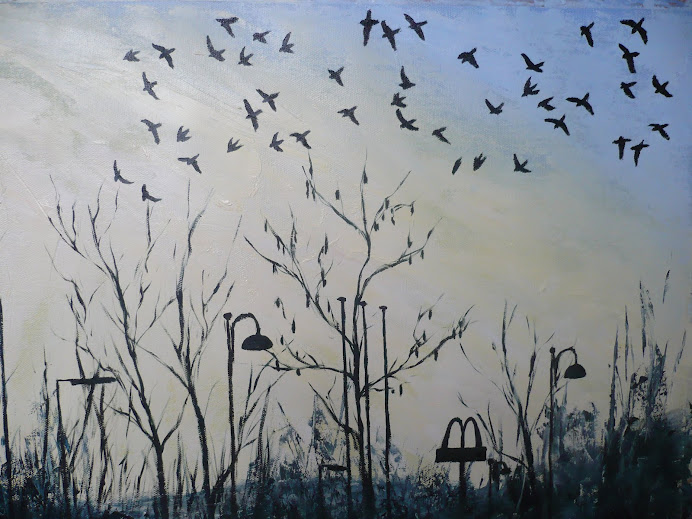Another book that has enriched my analysis and appreciation of art, especially landscape art, is the book "The Painter's Quarry, The Art of Peter Prendergast" published in 2006 by Gwasg Gomer, which features seven essays written about the artist. Prendergast came to my awareness thanks to a recomendation by one of the tutors on the college forum (one who had been lucky enough to work with him in the past). If I had to describe his paintings in simple terms it would be messy, but messy in a wonderful sense, like rubbing soil into the canvas, with the main difference between soil and his paintings being the colours, as his are like a rainbow of intensity, colours bleeding and blending into each other in such an exciting way. If painting outside is what creates a painting like Prendergast's then I'm all up for it. The essay by John Russell Taylor on page 12 mentions "the emotion he experiences in front of a landscape dictates the movement of the brush quite as much as the physical shape of the scene before him. Thus the paint is applied in great swathes of colour, constantly threatening to burst out of control and run riot all over the picture, moving it insensibly from expressionism to abstract expressionism."
Another passage I want to make note of is on page 11; "A landscape in nature may be beautifully composed, an artwork waiting to happen, but a landscape is the work of a mind and hand as well as an eye" which reminds me of the quote from the book "Art and Illusion" that a painting is a "corner of nature seen through a temperament," which again makes me think of John Piper. There is a thread running through these artists because on page 14 Taylor makes mentions the John Piper paintings of Windsor castle and the response of the kings to the "terrible weather" in Pipers paintings, a feature prominent in Prendergasts paintings too. "Chaos lies in wait ready to engulf art and artist, (p14)" this in response to the wonderful messy style of Predergast, like Auerbach his teacher at the Slade, whose representations of the landscape sometimes lie on a knife-edge.
It is important to think of the human being in the landscape, even if one isn't visible in the composition,and Prendergast makes his human presense well known in the landscape as he creates the majority of his paintings on site, even having to tie down the canvases in strong winds. These intense elements of wind, rain and sun are what feeds into his powerful paintings, full of movement and passion, and whilst looking at them it is so apparent that this is a human being responding to being in a landscape, not just an automaton capturing a moment for posterity; "very direct contact with the scene that inspire him remains an absolute necessity. Prendergast is a reactor, and his art is all about his reactions rather than about the phenomena that trigger them." (p.15)
Peter Wakelin writes on page 35 about the turning point in Prendergast's work when he saw an exhibition in the Tate London of the work by Oskar Kokoshka in 1962. The expressive dynamic properties of this artist spoke deeply to the young Prendergast, and coupled with the influence of his tutor Frank Auerbach confirmed to him that focusing on the structure underneath appearance was of the utmost importance to him. Page 74 in an essay by Robert Macdonald quotes the artist saying; "I have to make drawings to understand the landscape. When I know it thoroughly I work on my paintings. A cloud may come by, the light may change, and with a few strokes I may be able to finish the painting. I wouldn't be able to do that unless I had spent time reassessing, reconstructing, reconsidering. Some might equate the work with children's scribbling. They don't realise all the work underneath. The paintings haven't just arrived from nowhere."
Finally on page 121 the author Tony Curtis quotes the artists saying a profound statement of his art; "For me the nature of landscape is important. I believe that if you could pull the earth back you could find out where the world came from. the picture is made from some sort of glorification, celebration of nature. I don't know what they do for other people. I know that painting helps make sense of my life, as a way of trying to understand myself, to see the world and justify myself in it."
The whole range of his paintings, from the linear panoramic views of the valleys in North Wales such as "Landscape near Bethesda from Parc" from 1973, through to the later more fluid seascapes such as "Rock Pool Below" from 2004-5 all speak of an intimate knowledge of the land and the sea and are deeply moving and interesting because of that knowledge.

No comments:
Post a Comment